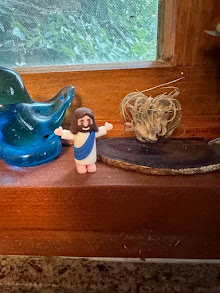
The storm was still foaming at the mouth when we pulled into the driveway the other night. It had been a white knuckle ride home, wind driving the rain across the road like an insane coachman cursing at his team. Several cars ahead stopped dead in their tracks in the middle of the highway, hazards flashing. We crept north, emerging from the heaviest rain as we pulled into Tarkio, then forced to zig and zag our way on the city streets dodging downed tree limbs. No shock, then, when we drove across the grass to avoid the leafy sycamore beast across our own driveway.
There was wreckage enough obvious as the brief blasts of lightening illumined our way to the back door. The summer flowers would never recover: sawed off at the pot were the big coleus and Persian shield. Several pieces of pottery had crashed on the concrete. We turned a blind eye and resolved to worry about it all in the morning.
Sure enough, it was as bad in daylight as we thought it might be in the dark. The windshield on the red pickup took a direct hit. There was enough debris to fill the flat bed and warrant a trip to town with a chainsaw. The siding on the back of the house was cratered like the moon.
And the window to the dining room was broken too.
That broken window tortures me. Why? Obviously, I don't like the idea of a hail stone shattering my leaded glass window and melting on my dining room table. But there is also a very famous theory about broken windows, a corollary of the slippery slope. The gist of this theory is that one broken window, one tipped over trash can, one abandoned vehicle, can lead inexorably to increased vandalism, crime, and worsening living standards and quality of life for the folks in the broken window neighborhood. While he was mayor, Rudy Guiliani put this theory to the test in his war on crime in New York City, increasing the police presence in neighborhoods and cleaning up vandalism and other symptoms of entropy. There are plenty of detractors to the broken window theory, most of which argue that this method of keeping order attacks the symptoms, not the disease, but appearances count in this vale of tears and cities still use James Q. Wilson's idea as a starting point.
This theory makes a lot of sense to this resident of small town America. I fixate on my shattered glass, fallen tree limbs and flattened flowers as indications that I don't care, rather than the results of a short and nasty act of God. I felt better the minute Ryan pulled out his chainsaw and sawed up the sycamore. From the roar of small gasoline engines in our end of town and the parade of pickups hauling debris to the refuse pile, most of our neighborhood had the same response to damage I did. This week, a visitor would be hard pressed to find evidence in town itself of the severe storm that rolled through here not long ago.
Tarkio will not be mistaken for Main Street in Disney Land. Storm or no storm, we have a fair share of continuing dilapidation. And broken windows are contagious.
Aye, there's the rub. Contrary to mainstream opinion, small towns are not bastions of rigidity, conformity and intolerance. Rather, we tend to have a more libertarian attitude most evidenced by the canard 'one man's trash is another man's treasure.' Using this definition, some property owners are rich indeed, in their own eyes. Their neighbors, on the other hand, may be more "eye-sore".
What to do? The up and down side of our little town is its crazy quilt-i-ness: its ability to take most comers and live and let live. But there can be too much tolerance; any curmudgeonly survivor of the 60s and other decades of excess will tell you that. I hope we can claw our way upwards to the imaginary point where we hold our own, winning some and losing some, tearing down but also building up, chalking up some progress on the growth chart that measures the life of our community.
But right now, all I can do is fix my window.















No comments:
Post a Comment